Top 10 Most Popular Semi-hard Cheeses in the World

Among the plethora of options available, semi-hard cheeses hold a special place in the hearts of cheese enthusiasts. They strike a perfect balance between texture and flavor, delivering a culinary experience that’s hard to resist. Whether you’re seeking the perfect cheese for your next gourmet recipe, or simply want to savor a slice with a glass of your favorite wine, our list of the Top 10 Most Popular Semi-hard Cheeses in the World will guide you on a delicious journey.
Top 10 Best Semi-hard Cheeses
| Cheese | Description | Tasting Profile | Country of Origin |
|---|---|---|---|
| Gouda | A semi-hard cheese with a rich, unique flavor and smooth texture. | It has a sweet, fruity flavor that becomes more complex as it ages. | Netherlands |
| Monterey Jack | Known for its mild flavor and good melting properties. | It has a mild flavor with a creamy, buttery taste. | United States |
| Cheddar | One of the most popular cheeses worldwide, Cheddar is off-white or orange if spices are added. | It has a creamy, savory, slightly earthy flavor. The taste becomes sharper and more complex with age. | England |
| Provolone | Made from cow’s milk. It’s usually formed into a cylindrical shape. | It varies from sweet and light when young to sharp and full-flavored when aged. | Italy |
| Cantal | One of the oldest French cheeses, Cantal has a firm texture similar to Cheddar and is made from cow’s milk. | It offers a mild, milky flavor with a slight hint of tanginess and buttery notes. | France |
| Appenzeller | Known for its spicy, fruity flavor, produced in the Appenzell region. | It has a tangy, fruity flavor with a hint of spiciness. | Switzerland |
| Comte | Made from unpasteurized cow’s milk. It’s known for its complexity of flavors. | It has a sweet and nutty flavor with a slight hint of earthiness. | France |
| Gruyere | Known for its creamy, nutty flavor. It’s commonly used in cooking. | It has a creamy, slightly salty flavor that varies widely with age. | Switzerland |
| Jarlsberg | Known for its mild flavor and large holes. | It has a sweet, nutty flavor with a hint of fruitiness. | Norway |
| Asiago | An Italian cheese that can take on different textures, according to its aging. | It offers a rich and nutty flavor, becoming more savory and sharp as it ages. | Italy |
1. Gouda
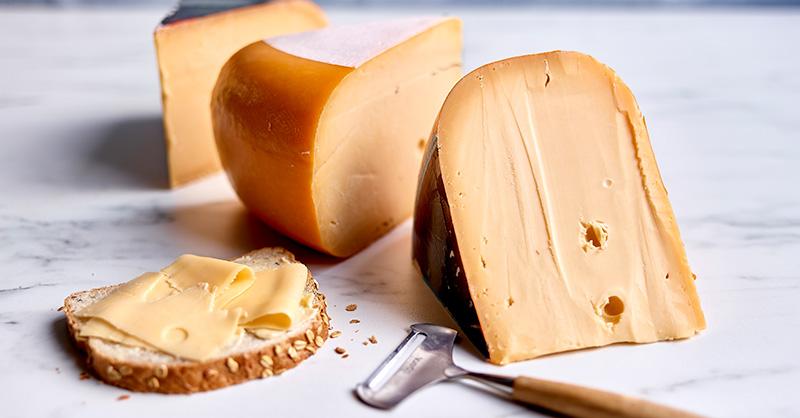
- Origin: The Netherlands
- Milk Type: Cow’s milk
- Taste: Sweet, fruity flavor that becomes more complex as it ages
- Aroma: Mild and creamy
- Texture: Smooth, firm, and dense
- Food pairing: Fruits like apples and pears, crusty breads, and dark chocolate
- Wine Pairing: Merlot, Cabernet Sauvignon, and Chardonnay
- Read in-depth guide
Gouda, originating from the Netherlands, is a semi-hard cheese celebrated for its rich, unique flavor and smooth texture. Made from cow’s milk, it has a sweet, slightly fruity taste that deepens as the cheese ages. Its creamy, dense texture makes it perfect for a wide array of culinary uses.
The mild aroma and distinctive taste of Gouda have made it one of the world’s most popular cheeses, enjoyed both on its own and paired with a variety of foods and wines.
2. Monterey Jack
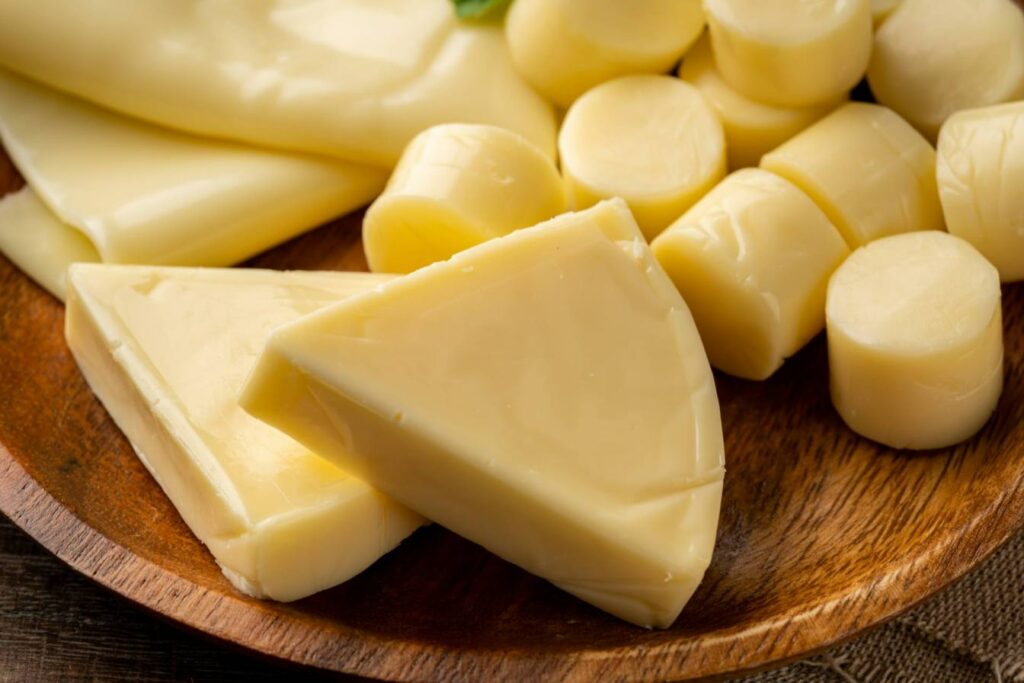
- Origin: United States
- Milk Type: Cow’s milk
- Taste: Mild, buttery flavor
- Aroma: Light and mild
- Texture: Creamy, semi-hard
- Food pairing: Melted on burgers, in sandwiches, or with Mexican dishes
- Wine Pairing: Riesling, Sauvignon Blanc, or light red wines
- Read in-depth guide
Monterey Jack is an all-American semi-hard cheese known for its mild and versatile flavor. Crafted from cow’s milk, it boasts a buttery, slightly sweet taste that makes it a favorite in many dishes. The texture is creamy and smooth, perfect for melting or slicing.
Its light and delicate aroma complements its mild flavor profile. Monterey Jack is a staple in Mexican cuisine and a popular choice for burgers and sandwiches, pairing well with a range of light wines.
3. Cheddar

- Origin: England
- Milk Type: Cow’s milk
- Taste: Creamy, savory, slightly earthy flavor. Becomes sharper and more complex with age.
- Aroma: Nutty to strong, depending on age
- Texture: Firm, smooth, or crumbly depending on age
- Food pairing: Apples, grapes, crackers, and in sandwiches
- Wine Pairing: Cabernet Sauvignon, Zinfandel, or Chardonnay
- Read in-depth guide
Cheddar is a highly popular semi-hard cheese originating from the village of Cheddar in England. Made from cow’s milk, it is known for its sharp, tangy flavor that intensifies with age. It has a firm and crumbly texture when aged, but is smoother and milder when younger.
The notable deep, nutty aroma adds to its allure. Cheddar’s versatility makes it an ideal cheese for a variety of dishes, from sandwiches and burgers to pasta and baked goods. It also pairs well with a range of wines and beers.
4. Provolone
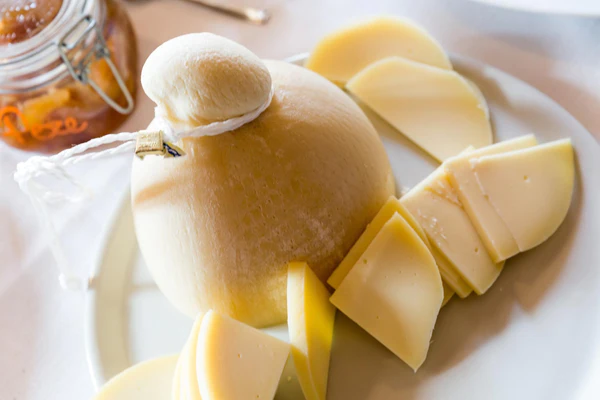
- Origin: Italy
- Milk Type: Cow’s milk
- Taste: Sweet and light when young, sharp and full-flavored when aged
- Aroma: Strong, piquant
- Texture: Smooth, semi-hard
- Food pairing: Melon, figs, crusty Italian bread, and prosciutto
- Wine Pairing: Full-bodied red wines, Chianti
- Read in-depth guide
Provolone is a traditional Italian semi-hard cheese known for its distinct, full-bodied flavor. Produced using cow’s milk, it has a slightly sharp taste with a hint of sweetness. The texture is smooth and firm, becoming grainier as it ages. Provolone is often recognized by its pear or cone shape and golden rind.
Its robust flavor profile makes it a versatile cheese, perfect for sandwiches, salads, or simply enjoyed with fruits and wine. From mild to sharp, Provolone offers a delicious range of flavors depending on its aging process.
5. Cantal

- Origin: France
- Milk Type: Cow’s milk
- Taste: Mild, milky flavor with a slight hint of tanginess and buttery notes
- Aroma: Grassy, hay-like
- Texture: Firm, dense, and creamy
- Food pairing: Hearty breads, fruit, charcuterie
- Wine Pairing: Full-bodied red wines, white Burgundy
- Read in-depth guide
Cantal is a distinguished semi-hard cheese hailing from the Cantal region of France. Made from cow’s milk, it possesses a rich, buttery flavor with a slight tang and notes of grass and nuts. The texture can range from firm and crumbly in younger varieties to hard and chewy when aged. Cantal has a thick, gray rind that adds to its rustic appeal.
This cheese is a versatile culinary companion, excellent for grating over dishes, melting into fondue, or savoring with fruits and wine. Its unique flavor profile makes Cantal a standout in the world of cheeses.
6. Appenzeller

- Origin: Switzerland
- Milk Type: Cow’s milk
- Taste: Nutty, fruity, tangy flavor
- Aroma: Mild to strong, depending on age
- Texture: Firm, dense, and creamy
- Food pairing: Traditional Swiss foods like fondue or raclette, hearty breads, fruits
- Wine Pairing: Full-bodied red wines, white Burgundy
- Read in-depth guide
Appenzeller is a renowned semi-hard cheese from the Alpine region of Switzerland, specifically the Appenzell area. Known for its distinct flavor, it’s crafted from raw, thermized cow’s milk sourced from cows grazing in the lush meadows of the region. The cheese wheels are washed with a unique herbal brine, giving it an added depth of flavor.
Appenzeller has a slightly grassy and nutty taste, which is a major step up from its robust aroma. This cheese is highly valued for its versatility and can be enjoyed in slices, melted into dishes, or paired with fruits and wine. Its rich, full-bodied character makes Appenzeller truly one of the great cheese specialities from Switzerland.
7. Comte

- Origin: France
- Milk Type: Cow’s milk
- Taste: Nutty, slightly sweet flavor
- Aroma: Strong, pungent
- Texture: Hard, dense, and grainy
- Food pairing: Grapes, nuts, and baguette
- Wine Pairing: French Jura wines, Chardonnay
- Read in-depth guide
Comté is a classic semi-hard cheese from the Franche-Comté region in eastern France. Made from unpasteurized cow’s milk, this cheese is celebrated for its complex flavor profile that can vary based on its age and the season of production. Comté’s taste can range from sweet and creamy to nutty and fruity, with an underlying hint of earthiness that reflects the rich pastures of its origin.
The cheese has a firm yet supple texture and a distinctive pale yellow color. Its versatility makes it perfect for anything from grating over dishes to enjoying on a cheese platter with fruits and wine. Comté’s depth of flavor and character make it a must-try for any cheese enthusiast.
8. Gruyere

- Origin: Switzerland
- Milk Type: Cow’s milk
- Taste: Sweet, slightly salty, nutty flavor
- Aroma: Rich and creamy
- Texture: Hard, dense, and smooth
- Food pairing: On a cheese plate, in sandwiches, or melted in dishes like fondue
- Wine Pairing: Full-bodied red wines, Riesling, Sauvignon Blanc
- Read in-depth guide
Gruyère is a premium semi-hard cheese originating from the town of Gruyères in Switzerland. Crafted with whole cow’s milk, this cheese is known for its smooth, creamy texture and slightly grainy feel. The flavor of Gruyère is complex – it starts off fruity, develops a nutty taste, and finishes with a sweet and slightly salty note. Its rind is dark and firm, providing a contrasting texture to its interior.
Aged for several months, the cheese develops small holes or ‘eyes’ during the maturation process. Gruyère’s melting properties make it perfect for dishes like fondue and gratins, but it can also be enjoyed on its own or with a glass of wine. This cheese is a testament to Swiss dairy craftsmanship and a delight for cheese lovers worldwide.
9. Jarlsberg
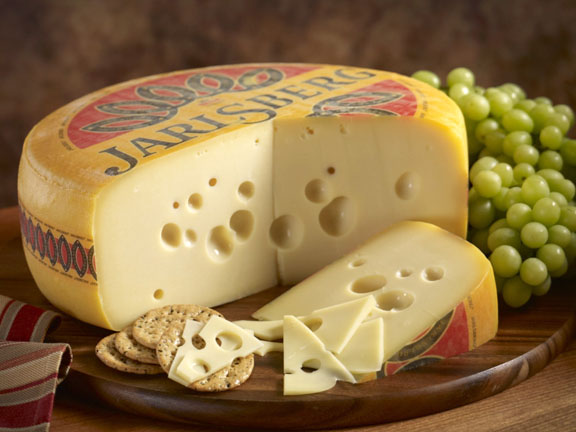
- Origin: Norway
- Milk Type: Cow’s milk
- Taste: Sweet, nutty flavor
- Aroma: Mild, buttery
- Texture: Semi-hard, with characteristic holes or “eyes”
- Food pairing: Crackers, fruits, and sandwiches
- Wine Pairing: Light red wines, Chardonnay, or fruity white wines
- Read in-depth guide
Jarlsberg is a highly-regarded semi-hard cheese hailing from Norway, recognized worldwide for its characteristic large, round holes. This cheese is made from cow’s milk and has a yellow-wax rind with a supple, buttery interior. Jarlsberg offers a delightfully mild, nutty flavor with a hint of sweetness that becomes more pronounced with aging.
The texture is smooth and slightly elastic, making it perfect for slicing and melting. Whether used in cooking, paired with crackers or fruits, or simply enjoyed on its own, Jarlsberg’s unique taste and texture make it a versatile and popular choice among cheese enthusiasts.
10. Asiago
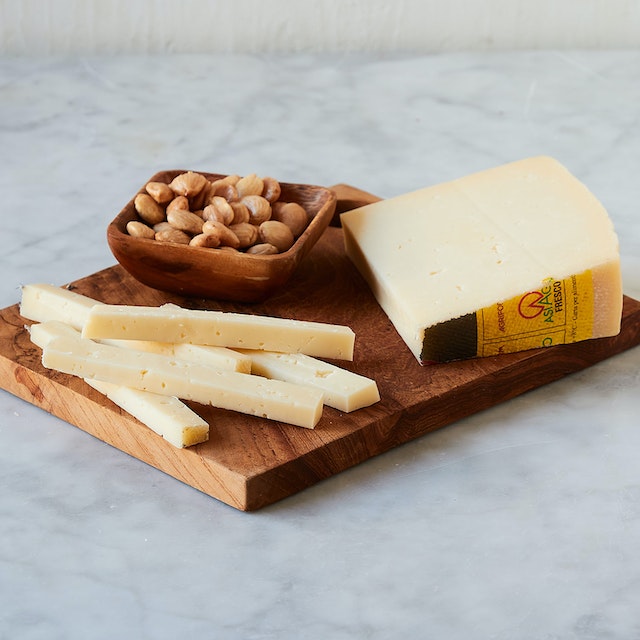
- Origin: Italy
- Milk Type: Cow’s milk
- Taste: Sweet and nutty when young, becomes more savory and sharp with age
- Aroma: Strong, pungent
- Texture: Semi-hard to hard, depending on age
- Food pairing: Pasta dishes, risotto, or on a cheese platter with fruits and nuts
- Wine Pairing: Full-bodied red wines, Pinot Grigio
- Read in-depth guide
Asiago is a distinctive semi-hard cheese from the Veneto and Trentino regions of Italy. Made from cow’s milk, it’s available in two varieties – Asiago Pressato, which is fresh and softer, and Asiago d’Allevo, which is aged and harder. The cheese has a compact texture that becomes crumbly with age and a thin, elastic rind that darkens over time.
Asiago boasts a rich, nutty, and slightly tangy flavor that intensifies as it matures. It can be used in a variety of culinary applications, from grating over pasta to pairing with fruits and wines, making it a versatile and appealing choice for cheese lovers.
Final Thoughts
As we conclude our cheesy adventure, it’s clear to see why these semi-hard cheeses have captured the hearts and palates of people across the globe. Each one possesses a unique character, a story, and a flavor profile that sets it apart. From the nutty sweetness of Jarlsberg to the robust tanginess of Asiago, these cheeses offer a world of culinary possibilities.
Whether you’re a seasoned cheese connoisseur or a curious novice, we hope this list of the Top 10 Most Popular Semi-hard Cheeses in the World has inspired you to explore the rich and diverse landscape of cheese. Remember, the best way to truly appreciate these cheeses is to taste them. So, go ahead, indulge in a slice or two and discover your new favorite!
Also read:
- What is Maredsous Cheese? Belgium’s Loaf-Shaped Legacy
- What is Fromage de Herve? Belgium’s Soft Cheese Sensation
- What is Appenzeller? The Swiss Cheese with a Secret Recipe
- What is Anari Cheese? Cyprus’ Creamy Culinary Secret
- What is Buttermilk Cheese? A Delicate Blend of Tanginess & Creaminess
- What is Whipped Cream? A Fluffy Delight in Every Spoonful
- What is Greek Yogurt? More Than Just a Dairy Product





